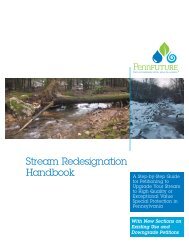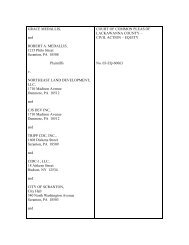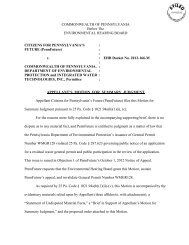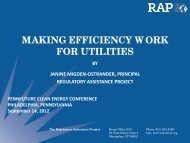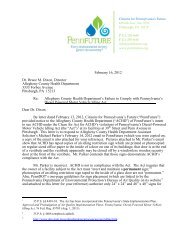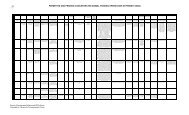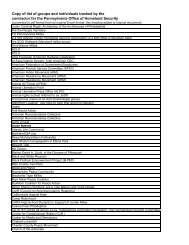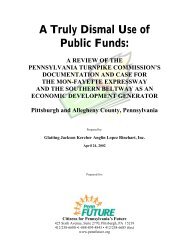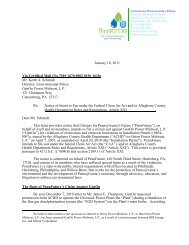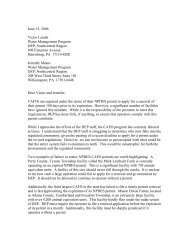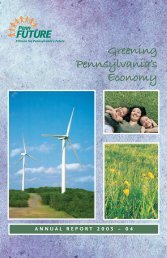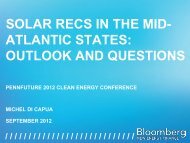A Review of the Pennsylvania Phosphorus Index ... - PennFuture
A Review of the Pennsylvania Phosphorus Index ... - PennFuture
A Review of the Pennsylvania Phosphorus Index ... - PennFuture
You also want an ePaper? Increase the reach of your titles
YUMPU automatically turns print PDFs into web optimized ePapers that Google loves.
1:100 extraction ratio (i.e. 2.5 g <strong>of</strong> manure in 250 ml <strong>of</strong> water or an equivalent ratio) which is <strong>the</strong>current standard procedure approved for use in calculating <strong>the</strong> PA P-<strong>Index</strong> (based uponKleinman et al. 2007). Studnicka et al (2011) found <strong>the</strong> 1:1000 water extraction ratio producedWEP estimates significantly higher than found with <strong>the</strong> 1:100 extraction ratio. Additionally,Studnicka et al (2007) found that WEP analysis <strong>of</strong> available manure P applied in <strong>the</strong> fall werenot well correlated with P run<strong>of</strong>f rates but were better predicted by <strong>the</strong> rate <strong>of</strong> available manureP applied. Fur<strong>the</strong>r, <strong>the</strong>y found that <strong>the</strong> run<strong>of</strong>f-to-rainfall ratio was <strong>the</strong> best predictor <strong>of</strong> run<strong>of</strong>f Pconcentrations across all seasons. In springtime, more rainfall infiltrates <strong>the</strong> soil relative to <strong>the</strong>fall and hence could help to explain why fall run<strong>of</strong>f P rates were higher than those during springapplication. However, as <strong>the</strong> run<strong>of</strong>f-to-rainfall ratios would not be known during <strong>the</strong> time <strong>of</strong>manure application, this relationship is not useable to determine allowable manure Papplication rates but ra<strong>the</strong>r would be valuable for modeling P run<strong>of</strong>f after <strong>the</strong> fact.Studnicka et al (2011) used a relatively small sample (0.25 g) relative to Kleinman et al (2007:0.5 – 100 g sample sizes evaluated). While Kleinmann et al (2007) found no relationshipbetween <strong>the</strong> weight <strong>of</strong> <strong>the</strong> sample and <strong>the</strong> relationship to dissolved P run<strong>of</strong>f, small sample sizescould be a problem with heterogeneous samples such as poultry litter (because <strong>of</strong> wood chips.)<strong>Phosphorus</strong> Source Coefficient: Influence on Allowable Manure <strong>Phosphorus</strong>To determine <strong>the</strong> influence <strong>of</strong> <strong>the</strong> PSC value on allowable manure P application rates, anexample from <strong>the</strong> <strong>Pennsylvania</strong> <strong>Phosphorus</strong> <strong>Index</strong>: Version 2 Users Guide (Beegle et al 2009)was modified and <strong>the</strong> maximum allowable manure application rates were calculated at 4different PSC values (Figure 1). <strong>Phosphorus</strong> solubility coefficients used in <strong>the</strong> calculation rangedfrom 0.8, which is <strong>the</strong> book value for dairy manure, to 0.2, which resulted in manure applicationbased upon crop nitrogen needs (i.e. no P application limits.) The specific conditions in <strong>the</strong>modified example P-<strong>Index</strong> calculations are provided in Table 1. As <strong>the</strong> Mehlich-3 soil test Plevels were above 200 ppm (201 ppm in this example), <strong>the</strong> need to calculate a P-<strong>Index</strong> wastriggered 1 . Under <strong>the</strong> example conditions, <strong>the</strong> P-<strong>Index</strong> calculation for manure application basedupon crop nitrogen needs resulted in a Very High P-<strong>Index</strong> rating (129) which would not allowany phosphorus to be applied.The P-<strong>Index</strong> was recalculated to find <strong>the</strong> maximum allowable manure P application rates foreach <strong>of</strong> <strong>the</strong> PSC values. Based upon <strong>the</strong> PSC Book value for dairy manure (0.8), <strong>the</strong> maximumallowable P rate was equivalent to crop removal (50 lbs P2O5/A) with a P-<strong>Index</strong> ranking <strong>of</strong> High(P-<strong>Index</strong> =86). The maximum allowable P application rates for PSC values <strong>of</strong> 0.6, 0.4, and 0.2were 52, 79 and 117 lbs P2O5/A, respectively. The P-<strong>Index</strong> ratings for <strong>the</strong> three PSC valuesbelow <strong>the</strong> Book value were in <strong>the</strong> Medium category (79, 79, 72, respectively) allowing nutrientsto be applied at nitrogen crop requirements (or at least as high a P application rate as wouldmaintain a P-<strong>Index</strong> below 80.) Only at <strong>the</strong> PSC <strong>of</strong> 0.2 did <strong>the</strong> P application rate actually equal<strong>the</strong> rate at <strong>the</strong> maximum allowable nitrogen application rate.1 Actually <strong>the</strong> example in Beegle et al 2009 shows a Mehlich-3 soil test concentration <strong>of</strong> 195 ppm whichwould not trigger <strong>the</strong> part B requirement although a P-<strong>Index</strong> was calculated for this farm field. For <strong>the</strong>purpose <strong>of</strong> <strong>the</strong> exercise in this report, a soil test concentration <strong>of</strong> 201 ppm was assumed.Page 4



